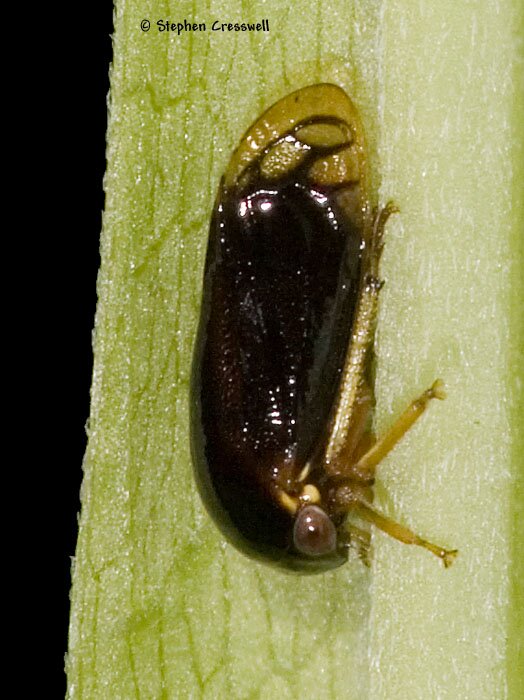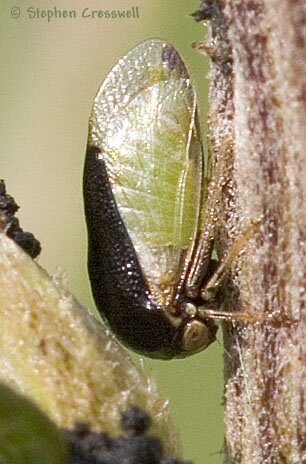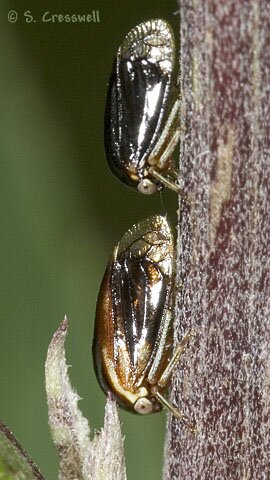
Family: Membracidae
Subfamily: Smiliinae
Length: 2.9-4.5 mm
Tsai and Kopp (1980) studied the life history of Acutalis tartarea in both field and laboratory.
For a host plant in the lab, the authors relied primarily on Common Ragweed, a natural host of this species. Females laid eggs in clusters of 12-15 eggs each, mostly in "the axis area of the leaf." The ovipositor slit the plant's epidermal tissue, and each egg was laid with about 1/3 of the egg exposed. The number of eggs per female ranged from 12 to 62, and the time from oviposition to hatching averaged about 16 days.
The nymphs in the early instars were largely sedentary and remained massed together. Later they spread out over the plant, feeding on petioles and the plant stems (but not leaves) in a head-down stance.
The average amount of time spent in instars one through five was 4.5, 5.5, 4.5, 6.6, and 12.1 days respectively. Thus in the laboratory the average time from oviposition to eclosion, on Ragweed, was about 49 days. A smaller number of nymphs were reared on China Aster, and the development time was much longer on this plant, at about 74 days on average.
In the field Tsai and Kopp found that Common Ragwood was the usual host plant, although another host in their Florida study area was Spanish Needles (Bidens sp.) They found that the number of adults and nymphs present was significantly lower in late Summer and early Fall, compared with earlier months.

For many decades there were three described species of this genus in the Nearctic, Acutalis tartarea, A. semicrema, and A. inornata, with the species being separated primarily by color. Careful field observations, however, proved that the color varieties are related to the individual's age and sex (females tend to have lighter pigmentation), and possibly to temperature and the identity of the host plant. The earliest researcher to cast doubt on the validity of the three separate species was Matausch in 1912, while Tsai and Kopp in 1980 removed any remaining doubt as they reported successfully interbreeding the various "species" in the laboratory with no apparently problems of infertility of the offspring.
This is a fairly dark species, with light-colored eyes and the tegmina apices abruptly hyaline. The ocelli are small and light-colored; the distance between the ocelli is about the same as the distance between an ocellus and its adjacent eye.
The dark pronotum is not pubescent, but is glossy and finely punctate.
The basal two-thirds of the tegmina are black, while the apical third is suddenly hyaline with heavy black veins. The legs are yellowish, though the tarsi may be darker.
Kopp and Yonke (1973) listed the host plants for Acutalis tartarea as Black Locust, Great Ragweed and other Ambrosia spp., and various species of Sunflower and Goldenrod. Kopp and Yonke's range map shows West Virginia and Maine as the only states east of the Mississippi without records for this species, but it is clearly present in West Virginia, as these Upshur County photographs attest. The species also ranges as far west as Texas and Utah.



